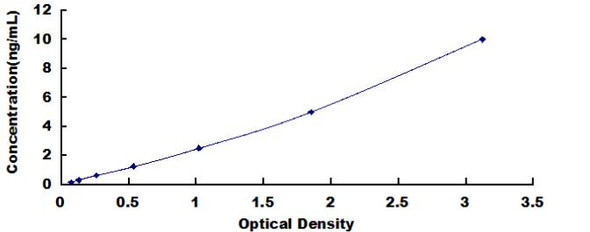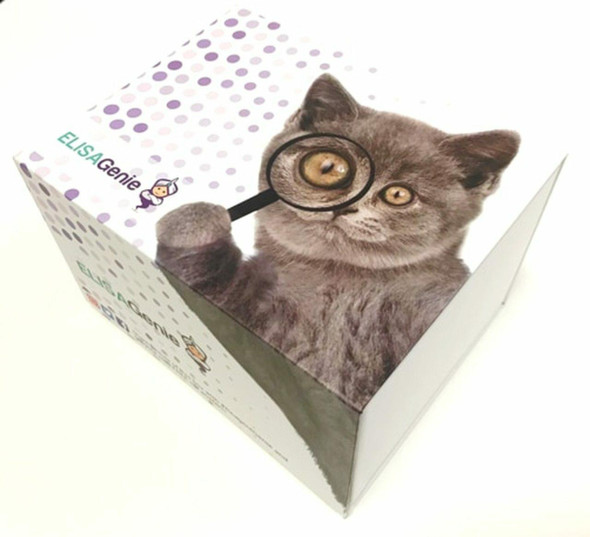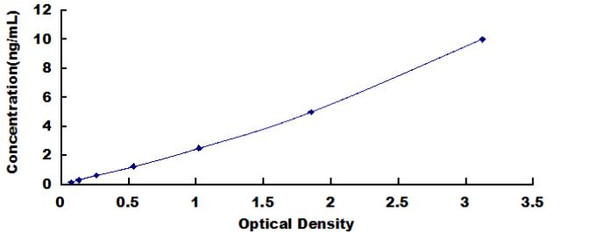Human CCR8 (Chemokine C-C-Motif Receptor 8) ELISA Kit (HUES01855)
- SKU:
- HUES01855
- Product Type:
- ELISA Kit
- Size:
- 96 Assays
- Uniprot:
- P51685
- Sensitivity:
- 0.09ng/mL
- Range:
- 0.16-10ng/mL
- ELISA Type:
- Sandwich
- Reactivity:
- Human
- Sample Type:
- Serum, plasma and other biological fluids
- Research Area:
- Cell Biology
Description
Human CCR8 (Chemokine C-C-Motif Receptor 8) ELISA Kit
The Human CCR8 (Chemokine C-C motif receptor 8) ELISA Kit is specifically designed for the accurate measurement of CCR8 levels in human serum, plasma, and cell culture supernatants. This kit offers high sensitivity and specificity, guaranteeing dependable and consistent results for various research purposes.CCR8 is a key receptor involved in immune responses, particularly in the migration and activation of specific immune cells. It plays a critical role in inflammatory and autoimmune diseases, making it a valuable biomarker for studying these conditions and potentially developing targeted therapies.
With its reliable performance and ease of use, the Human CCR8 ELISA Kit is an essential tool for researchers studying immune responses, inflammation, and autoimmune disorders. Get accurate and reproducible results with this high-quality ELISA kit from Assay Genie.
| Assay type: | Sandwich |
| Format: | 96T |
| Assay time: | 4.5h |
| Reactivity: | Human |
| Detection Method: | Colormetric |
| Detection Range: | 15.63-1000 pg/mL |
| Sensitivity: | 9.38 pg/mL |
| Sample Volume Required Per Well: | 100µL |
| Sample Type: | Serum, plasma and other biological fluids |
| Specificity: | This kit recognizes Human CCR8 in samples. No significant cross-reactivity or interference between Human CCR8 and analogues was observed. |
This ELISA kit uses Sandwich-ELISA as the method. The micro ELISA plate provided in this kit has been pre-coated with an antibody specific to Human CCR8. Standards or samples are added to the appropriate micro ELISA plate wells and combined with the specific antibody. Then a biotinylated detection antibody specific for Human CCR8 and Avidin-Horseradish Peroxidase (HRP) conjugate are added to each micro plate well successively and incubated. Free components are washed away. The substrate solution is added to each well. Only those wells that contain Human CCR8, biotinylated detection antibody and Avidin-HRP conjugate will appear blue in color. The enzyme-substrate reaction is terminated by adding Stop Solution and the color turns yellow. The optical density (OD) is measured spectrophotometrically at a wavelength of 450 nm ± 2 nm. The OD value is proportional to the concentration of Human CCR8. The concentration of Human CCR8 in samples can be calculated by comparing the OD of the samples to the standard curve.
| UniProt Protein Function: | CCR8: Receptor for the chemokine CCL1/SCYA1/I-309. May regulate monocyte chemotaxis and thymic cell line apoptosis. Alternative coreceptor with CD4 for HIV-1 infection. Belongs to the G-protein coupled receptor 1 family. |
| UniProt Protein Details: | Protein type:Membrane protein, integral; Receptor, GPCR; GPCR, family 1; Membrane protein, multi-pass; Motility/polarity/chemotaxis Chromosomal Location of Human Ortholog: 3p22 Cellular Component: integral to plasma membrane; plasma membrane Molecular Function:C-C chemokine receptor activity; chemokine receptor activity; coreceptor activity Biological Process: G-protein coupled receptor protein signaling pathway; elevation of cytosolic calcium ion concentration; immune response; chemotaxis; cell adhesion |
| NCBI Summary: | This gene encodes a member of the beta chemokine receptor family, which is predicted to be a seven transmembrane protein similar to G protein-coupled receptors. Chemokines and their receptors are important for the migration of various cell types into the inflammatory sites. This receptor protein preferentially expresses in the thymus. I-309, thymus activation-regulated cytokine (TARC) and macrophage inflammatory protein-1 beta (MIP-1 beta) have been identified as ligands of this receptor. Studies of this receptor and its ligands suggested its role in regulation of monocyte chemotaxis and thymic cell apoptosis. More specifically, this receptor may contribute to the proper positioning of activated T cells within the antigenic challenge sites and specialized areas of lymphoid tissues. This gene is located at the chemokine receptor gene cluster region. [provided by RefSeq, Jul 2008] |
| UniProt Code: | P51685 |
| NCBI GenInfo Identifier: | 1707884 |
| NCBI Gene ID: | 1237 |
| NCBI Accession: | P51685. 1 |
| UniProt Secondary Accession: | P51685,Q3KNQ8, Q3KNR3, Q9BYX5, B2RC64, |
| UniProt Related Accession: | P51685 |
| Molecular Weight: | |
| NCBI Full Name: | C-C chemokine receptor type 8 |
| NCBI Synonym Full Names: | chemokine (C-C motif) receptor 8 |
| NCBI Official Symbol: | CCR8 |
| NCBI Official Synonym Symbols: | CY6; TER1; CCR-8; CKRL1; CDw198; CMKBR8; GPRCY6; CMKBRL2; CC-CKR-8 |
| NCBI Protein Information: | C-C chemokine receptor type 8; CC chemokine receptor 8; chemokine receptor-like 1; chemokine (C-C) receptor 8; CC chemokine receptor CHEMR1; CC-chemokine receptor chemr1; chemokine (C-C) receptor-like 2 |
| UniProt Protein Name: | C-C chemokine receptor type 8 |
| UniProt Synonym Protein Names: | CC chemokine receptor CHEMR1; CMKBRL2; Chemokine receptor-like 1; CKR-L1; GPR-CY6; GPRCY6; TER1; CD_antigen: CDw198 |
| Protein Family: | C-C chemokine receptor |
| UniProt Gene Name: | CCR8 |
| UniProt Entry Name: | CCR8_HUMAN |
As the OD values of the standard curve may vary according to the conditions of the actual assay performance (e. g. operator, pipetting technique, washing technique or temperature effects), the operator should establish a standard curve for each test. Typical standard curve and data is provided below for reference only.
| Concentration (pg/mL) | O.D | Average | Corrected |
| 1000 | 2.307 2.341 | 2.324 | 2.249 |
| 500 | 1.643 1.647 | 1.645 | 1.57 |
| 250 | 0.991 0.971 | 0.981 | 0.906 |
| 125 | 0.505 0.541 | 0.523 | 0.448 |
| 62.5 | 0.292 0.272 | 0.282 | 0.207 |
| 31.25 | 0.186 0.166 | 0.176 | 0.101 |
| 15.63 | 0.121 0.133 | 0.127 | 0.052 |
| 0 | 0.068 0.082 | 0.075 | -- |
Precision
Intra-assay Precision (Precision within an assay): 3 samples with low, mid range and high level Human CCR8 were tested 20 times on one plate, respectively.
Inter-assay Precision (Precision between assays): 3 samples with low, mid range and high level Human CCR8 were tested on 3 different plates, 20 replicates in each plate.
| Intra-assay Precision | Inter-assay Precision | |||||
| Sample | 1 | 2 | 3 | 1 | 2 | 3 |
| n | 20 | 20 | 20 | 20 | 20 | 20 |
| Mean (pg/mL) | 54.35 | 100.14 | 494.35 | 59.65 | 97.63 | 482.33 |
| Standard deviation | 2.78 | 5.08 | 17.90 | 4.16 | 5.35 | 15.48 |
| C V (%) | 5.11 | 5.07 | 3.62 | 6.97 | 5.48 | 3.21 |
Recovery
The recovery of Human CCR8 spiked at three different levels in samples throughout the range of the assay was evaluated in various matrices.
| Sample Type | Range (%) | Average Recovery (%) |
| Serum (n=5) | 89-103 | 96 |
| EDTA plasma (n=5) | 88-100 | 94 |
| Cell culture media (n=5) | 96-112 | 102 |
Linearity
Samples were spiked with high concentrations of Human CCR8 and diluted with Reference Standard & Sample Diluent to produce samples with values within the range of the assay.
| Serum (n=5) | EDTA plasma (n=5) | Cell culture media (n=5) | ||
| 1:2 | Range (%) | 97-112 | 89-102 | 87-103 |
| Average (%) | 103 | 97 | 94 | |
| 1:4 | Range (%) | 87-100 | 80-95 | 87-103 |
| Average (%) | 93 | 87 | 94 | |
| 1:8 | Range (%) | 92-105 | 88-99 | 85-98 |
| Average (%) | 98 | 93 | 92 | |
| 1:16 | Range (%) | 91-106 | 83-98 | 81-94 |
| Average (%) | 97 | 90 | 88 |
An unopened kit can be stored at 4°C for 1 month. If the kit is not used within 1 month, store the items separately according to the following conditions once the kit is received.
| Item | Specifications | Storage |
| Micro ELISA Plate(Dismountable) | 8 wells ×12 strips | -20°C, 6 months |
| Reference Standard | 2 vials | |
| Concentrated Biotinylated Detection Ab (100×) | 1 vial, 120 µL | |
| Concentrated HRP Conjugate (100×) | 1 vial, 120 µL | -20°C(shading light), 6 months |
| Reference Standard & Sample Diluent | 1 vial, 20 mL | 4°C, 6 months |
| Biotinylated Detection Ab Diluent | 1 vial, 14 mL | |
| HRP Conjugate Diluent | 1 vial, 14 mL | |
| Concentrated Wash Buffer (25×) | 1 vial, 30 mL | |
| Substrate Reagent | 1 vial, 10 mL | 4°C(shading light) |
| Stop Solution | 1 vial, 10 mL | 4°C |
| Plate Sealer | 5 pieces | |
| Product Description | 1 copy | |
| Certificate of Analysis | 1 copy |
- Set standard, test sample and control (zero) wells on the pre-coated plate and record theirpositions. It is recommended to measure each standard and sample in duplicate. Note: addall solutions to the bottom of the plate wells while avoiding contact with the well walls. Ensuresolutions do not foam when adding to the wells.
- Aliquot 100 µL of standard solutions into the standard wells.
- Add 100 µL of Sample / Standard dilution buffer into the control (zero) well.
- Add 100 µL of properly diluted sample (serum, plasma, tissue homogenates and otherbiological fluids) into test sample wells.
- Cover the plate with the sealer provided in the kit and incubate for 90 min at 37 °C.
- Aspirate the liquid from each well, do not wash. Immediately add 100 µL of BiotinylatedDetection Ab working solution to each well. Cover the plate with a plate seal and gently mix. Incubate for 1 hour at 37 °C.
- Aspirate or decant the solution from the plate and add 350 µL of wash buffer to each welland incubate for 1-2 minutes at room temperature. Aspirate the solution from each well andclap the plate on absorbent filter paper to dry. Repeat this process 3 times. Note: a microplatewasher can be used in this step and other wash steps.
- Add 100 µL of HRP Conjugate working solution to each well. Cover with a plate seal andincubate for 30 min at 37 °C.
- Aspirate or decant the solution from each well. Repeat the wash process for five times asconducted in step 7.
- Add 90 µL of Substrate Reagent to each well. Cover with a new plate seal and incubate forapproximately 15 min at 37 °C. Protect the plate from light. Note: the reaction time can beshortened or extended according to the actual color change, but not by more than 30min.
- Add 50 µL of Stop Solution to each well. Note: Adding the stop solution should be done inthe same order as the substrate solution.
- Determine the optical density (OD value) of each well immediately with a microplate readerset at 450 nm.










